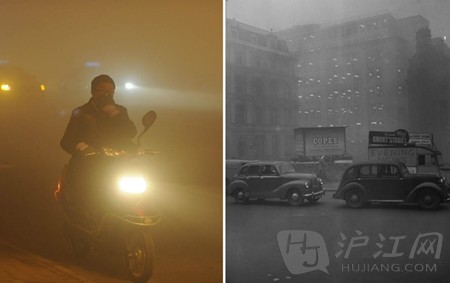Domestic serious air pollution in London fog event again
Have already visited 130103/26/2015On Dec. 5, 1952, a thick layer of fog settled over the streets of London, blanketing the city. This was no ordinary wintery mist, but rather a noxious haze of sulfur dioxide from coal-fired industrial factories and cookstoves in London homes. London's Great Smog hung in the air for five consecutive days; visibility was reduced to mere feet and cars were abandoned or led off the road by police with traffic flares. It was the "nation's worst air pollution disaster" and remains the deadliest smog event on record.
According to the Telegraph, the devastation the smog wrought "only bec ame apparent when undertakers reported that they were running out of coffins and florists had sold all their flowers." In the following three months, an estimated 13,000 people died of respiratory complications.
The hazy scenes of London's Great Smog bear a striking resemblence to modern-day images of China's urban centers on their most polluted days. And though China has never had an event to match those four days in London, its pollution problem is persistent and pervasive. In 2010, air pollution contributed to 1.2 million deaths in China. Between 1981 and 2001, particulate levels in its major cities were five times greater than what the United States experienced before 1970.
And the problem is worsening at an incredible rate. In 2009, the concentration of particulate pollution in the Chinese city of Harbin averaged 101 micrograms per meter, according to the World Health Organization. Four years later, in October 2013, levels were up tenfold, a new record.
This week, Gina McCarthy, the new head of the Environmental Protection Agency (EPA), said she would be meeting with partners in China in the coming days to address air pollution issues, but was careful to stress that this is not an challenge limited to China. The West, too, has faced hazardous pollution. "We have been there before," she said on Monday, Dec. 2. The comparison bears consideration; what follows is a series of photo pairings -- smog in London then, and in China now.

London's Great Smog rolled into city's streets on a "mass of cold air," and remained, trapped by a layer of warmer air above. PM 2.5 -- the mass, in micrograms, of particles larger than 2.5 micrometers in a cubic centimeter, a common measure of hazardous air pollution -- rocketed to 1,600, a record China has yet to approach even on its worst days.
Perhaps the closest China has come was the smog that settled over Harbin, a city of 10 million people in northeast China, in October. As PM 2.5 climbed to 1,000, the city effectively shut down, closing schools, airports, and highways.
The Great Smog of 1952 prompted Britain's 1956 Clean Air Act, which led to legislation in the United States. In New York, in particular, pollution had bec ome a major problem: particularly deadly clouds of smog were blamed for 200 deaths in 1963 and 168 more in 1966. These events were pivotal in motivating Congress to establish the EPA and pass landmark clean air laws. Like China today, most of that pollution was caused by burning coal and, to a lesser extent, by heavy traffic in cities like Los Angeles.
"We know what planning can do," McCarthy said of the EPA's work with China. "We know there are many ways in which you can engage your states, and in China's case provinces, to bring a sense of urgency to this issue."
"I am hopeful," she said. "One of the reasons I am hopeful is that I know what we've been able to accomplish in the United States."
I want to comment
- Prev: Sewage treatment process optimization and comparison
- Next: No Content







 Chunqiu Road 2#, Hutang Town, Changzhou City, Jiangsu Province
Chunqiu Road 2#, Hutang Town, Changzhou City, Jiangsu Province +86-519-86538239
+86-519-86538239 
 Skype1
Skype1
View More(Total0)Comment Lists